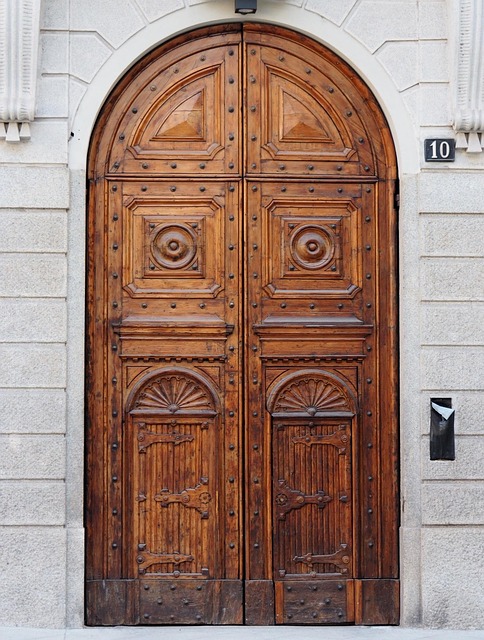Handicap-accessible door options, adhering to ADA guidelines, are crucial for inclusive design, ensuring equal access and usability for all. These doors feature minimal clearance requirements (at least 32 inches) and user-friendly mechanisms like automated sensors or handles. Adequate clearances enable safe navigation for mobility aids and visually impaired individuals, fostering independence. Essential hardware, such as lever handles and advanced features, caters to diverse abilities, enhancing accessibility. Correct installation and regular maintenance, including hinge lubrication and damage checks, are vital to preserve functionality and user experiences in high-traffic public spaces.
“In today’s inclusive spaces, ensuring every visitor can navigate effortlessly is paramount. This article explores handicap-accessible door options, specifically focusing on swinging doors that meet ADA (Americans with Disabilities Act) compliance standards. We’ll delve into the essential features and clearances that facilitate easy operation, discuss hardware solutions enhancing accessibility, and provide guidance on seamless installation and maintenance. Understanding these requirements opens a world of inclusive design possibilities.”
Understanding Handicap-Accessible Door Requirements
Handicap-accessible door options are designed to ensure equal access and usability for individuals with disabilities, following ADA (Americans with Disabilities Act) guidelines. These requirements focus on clearances wide enough for wheelchairs and other mobility devices, typically 32 inches in width, along with ease of operation mechanisms such as automated sensors or handles that require minimal effort to activate.
Understanding these standards is crucial when installing or retrofitting doors to accommodate all users. The ADA provides detailed specifications for door openings, including height and clearance dimensions, to guarantee comfortable passage. Additionally, operational features like push or pull handles, automatic sensors, and lap hinges contribute to a seamless experience for those with limited mobility.
Key Features of ADA-Compliant Swinging Doors
When it comes to ensuring accessibility for all, especially those with disabilities, ADA-compliant swinging doors play a pivotal role. These doors are designed with key features that cater to handicap-accessible door options, making public spaces more inclusive and user-friendly. One of the primary considerations is clearance; these doors must provide ample space for individuals using mobility aids, such as wheelchairs or walkers, to navigate through comfortably and safely.
Another essential feature is smooth, effortless operation. ADA-compliant doors are equipped with easy-to-use hardware, like handles or levers, that allow for simple opening and closing. This not only facilitates access but also promotes independence for individuals with physical limitations, ensuring they can enter and exit buildings with ease and without assistance.
Benefits of Clearances for Easy Operation
Clearances play a pivotal role in ensuring smooth and safe operation for everyone, including those who rely on handicap-accessible door options. Adequate clearances allow for comfortable passage, free from obstacles or tight spaces that could hinder movement. This is particularly beneficial for individuals with limited mobility or visual impairments, as it enables them to navigate through doors effortlessly and independently.
By providing the necessary clearances, these doors become inclusive, fostering accessibility and ease of use for all. It’s a simple yet powerful way to eliminate barriers and promote equal access, aligning perfectly with the principles of handicap-accessible design.
Types of Hardware and Their Roles in Accessibility
In ensuring handicap-accessible door options, the hardware plays a pivotal role in facilitating ease of operation for all individuals, regardless of their abilities. Door handles and pulls are fundamental components, designed to be comfortable and accessible for users with diverse physical capabilities. For instance, lever handles offer a smooth, effortless grip, accommodating those with limited hand dexterity or mobility issues.
Additionally, the integration of features like proximity sensors and automatic door openers further enhances accessibility. These technologies detect the presence of individuals, opening doors without the need for manual interaction, which is especially beneficial for those using wheelchairs or other mobility aids. The selection of suitable hardware ensures not only compliance with ADA standards but also fosters an inclusive environment where every person can navigate spaces comfortably and independently.
Ensuring Smooth Installation and Maintenance
When it comes to installing and maintaining swinging doors, especially those catering to handicap-accessible door options, a seamless process is paramount. The clearances for these doors must adhere to ADA guidelines, ensuring ease of operation for all users, including individuals with disabilities. Proper installation involves precise measurement and adjustment to meet the required width and height standards, guaranteeing a comfortable and unobstructed passage.
Regular maintenance plays a crucial role in keeping these doors in top condition. This includes lubricating hinges, checking for any signs of damage or wear, and ensuring all mechanisms operate smoothly. A well-maintained swinging door not only enhances the user experience but also contributes to safety, especially in public spaces where foot traffic is high.
In conclusion, implementing ADA-compliant swinging doors is a significant step towards creating inclusive spaces that cater to all users. By understanding the key features and benefits outlined in this article—from clearances for easy operation to the role of specialized hardware—you can ensure that handicap-accessible door options are not only compliant with regulations but also seamlessly integrated into your environment, promoting accessibility and comfort for everyone.
